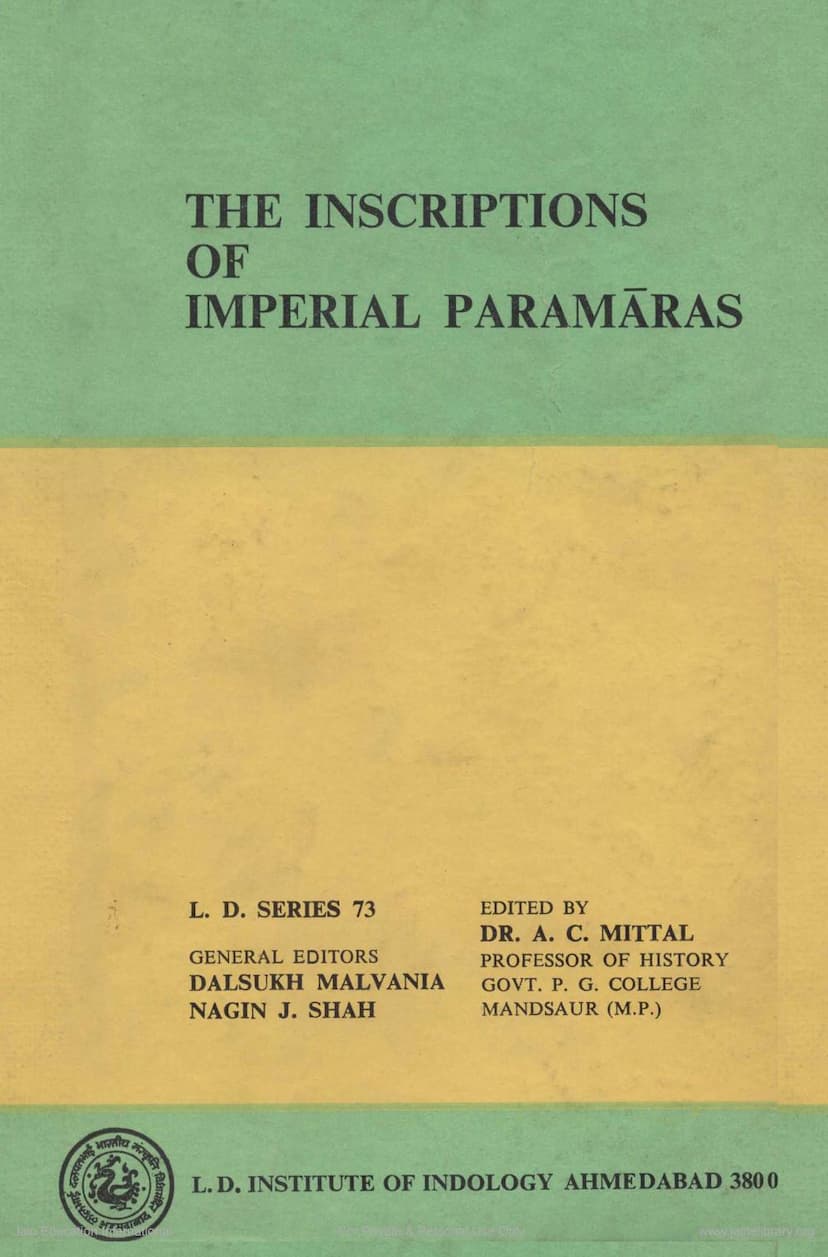Parmaras Abhilekh
Added to library: September 2, 2025

Summary
This document is an academic publication titled "The Inscriptions of Imperial Paramaras" (800 A.D. to 1322 A.D.) edited by Dr. A.C. Mittal and published by L.D. Institute of Indology, Ahmedabad. It is part of the L.D. Series 73, with DalSukh Malvania and Nagin J. Shah as General Editors. The book was first published in June 1979 and received financial support from the Indian Council of Historical Research.
The book is a comprehensive compilation and critical study of 85 inscriptions related to the Imperial Paramara dynasty, which ruled from approximately 800 A.D. to 1320 A.D. Dr. Mittal has meticulously collected these inscriptions, providing detailed commentary and Hindi translations for each.
The publication includes:
- A Detailed Introduction: This section covers various significant aspects of the Paramara empire, including:
- Geographical and physical location of the empire.
- Origin of the Paramaras (discussing theories of Agnikula, Gurjar, Rashtrakuta, and Brahmakshatra origins).
- Importance of Paramara inscriptions.
- Classification of inscriptions.
- Basis for constructing the dynastic tree.
- Determination of the reign periods of the rulers.
- Information about the engravers, scribes, and writing methods.
- Political and Administrative Structure: The book delves into the intricacies of the Paramara administration, including:
- Central government (monarchical system, succession, council of ministers).
- Key ministers and officials (Mahapradhana, Mahasandhivigrahika, Mahadandanayaka, Mahapratiraha, Rajguru, Mahapurohit).
- Administrative divisions (Mandala, Vishaya, Bhoga, Pathaka, Pratiraganaka, village groups, villages).
- Military organization.
- Judicial system.
- Police system.
- Revenue and taxation departments.
- Civil administration and village organization.
- Social, Economic, and Religious Conditions: The inscriptions provide valuable insights into:
- Religious practices, including the worship of various deities, Surya puja, Jainism, and pilgrimage.
- Social hierarchy (Brahmins, Kshatriyas, Vaishyas, Kayasthas, position of women).
- Economic systems, irrigation, crafts, trade, guilds, weights and measures, and coinage.
- List and Analysis of Inscriptions: The core of the book is the detailed presentation and analysis of the 85 inscriptions, categorized as:
- Copper plate grants (Tamrapatras).
- Stone inscriptions (Prastarakhanda).
- Inscription on statues (Pratima Lekh).
- Pillar inscriptions (Stambha Lekh).
- Nagabandha inscriptions.
- Praise inscriptions (Stuti).
- The book provides details for each inscription, including its number, location, ruler, date, language, script, paleography, donation details, and historical significance.
- Illustrations: The book includes images of various inscriptions and maps, enhancing its utility for researchers and students.
Key Historical Contributions highlighted by the inscriptions:
The inscriptions have shed new light on several historical aspects of the Paramara dynasty, particularly:
- Succession Issues: Clarifying the succession following Bhoja's childless death, highlighting the struggle between Jayasimha I and Udayaditya, and the relationship between Udayaditya and Bhoja.
- Udayaditya's Succession: Correcting the previous understanding that Udayaditya's eldest son Lakshmadeva succeeded him. New inscriptions confirm that Lakshmadeva died during his father's reign, and it was his second son Naravarman who became the successor.
- Jagaddeva's Role: The inscription evidence suggests Jagaddeva, the third son, might have been a provincial governor in the Berar region, which was outside the main Paramara empire, possibly serving the Chalukyas of Kalyani due to family ties.
- Dynastic Chronology: The analysis of inscriptions aids in establishing a clearer succession and reign periods of the Paramara rulers.
- Imperial Expansion: The locations of the inscriptions help delineate the precise territorial expansion of the Paramara empire.
The author acknowledges the extensive use of previous research journals and works, while also asserting the originality of many of his analytical thoughts and arguments. The publication of this significant work in Hindi is also highlighted as a valuable contribution to scholarship.
In essence, "Parmaras Abhilekh" is a foundational work for understanding the Imperial Paramara dynasty, offering a wealth of epigraphic data analyzed with scholarly rigor, making it an indispensable resource for historians of medieval India.